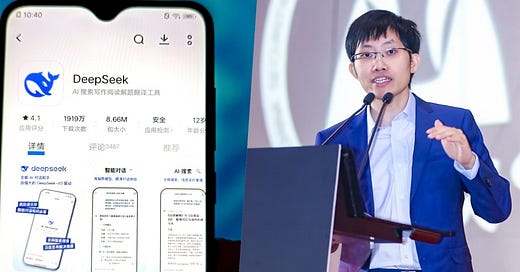DeepSeek and the Reluctant Disruptor
How Founder Liang Wenfeng is Redefining China’s AI Ambitions
Few entrepreneurs in China’s burgeoning artificial intelligence sector have sparked as much intrigue as Liang Wenfeng, the founder of DeepSeek.
A quiet yet calculated force in the industry, Liang has propelled his company to the forefront of AI research—not merely as a competitor to China’s technology giants but as a rare proponent of fundamental research over rapid commercialization.
In doing so, he has inadvertently ignited a price war and challenged long-standing industry norms.
Liang Wenfeng: The Visionary Behind DeepSeek
Name: Liang Wenfeng
Born: 1985, Zhanjiang, Guangdong, China
Education: Bachelor’s and Master’s degrees in Electronic Information Engineering and Information & Communication Engineering from Zhejiang University
Liang’s academic excellence was evident early on, securing a place at Zhejiang University at the age of 17.
During his university years, he developed a keen interest in financial markets, actively participating in technology competitions and gaining hands-on experience.
His research during his postgraduate studies led to the formation of an AI-focused team, attracting the attention of DJI founder Wang Tao.
The Accidental Catalyst
When DeepSeek released its V2 model, it set off an intense price war among China’s AI firms, according to AnyongWaves’ interview with Liang Wenfeng last year.
Despite Liang’s insistence that the company had no intention of being a market disruptor, its decision to price its API access modestly—balancing cost recovery with minimal profit—forced ByteDance, Alibaba, Tencent, and Baidu to follow suit.
The move highlighted a stark reality: the cost structure of China’s tech behemoths is significantly higher than that of a lean, research-driven firm like DeepSeek.
But Liang insists this was an unintended consequence. “We simply priced according to our costs,” he says. “We didn’t expect pricing to be such a sensitive issue.”
While many saw DeepSeek’s move as a play to undercut rivals and seize market share, Liang maintains that the company’s primary objective is to push AI research forward rather than engage in a commercial battle.
An Unconventional Path
Liang’s background offers insight into his unique approach.
Having founded Hangzhou Yakebi Investment Management Co. and later High-Flyer Quant, one of China’s most successful hedge funds with $8 billion in assets under management, he demonstrated an early penchant for leveraging artificial intelligence in quantitative finance.
However, unlike many entrepreneurs who pivot to AI for its lucrative applications, Liang’s motivation was fundamentally research-driven.
DeepSeek operates independently from High-Flyer, focusing exclusively on the development of general AI models.
Unlike most Chinese AI startups, which hasten to commercialize by adopting open-source models like Meta’s Llama, DeepSeek has prioritized foundational research, seeking to reduce the efficiency gap between Chinese and Western AI models.
Liang estimates that, on average, China’s best AI models require four times the computational resources of their American counterparts to achieve similar results.
Originality vs. Imitation
For decades, China’s technology ecosystem has been characterized by rapid adaptation and commercialization of Western innovations.
Liang sees this as an impediment to China’s technological future. “China has grown accustomed to Moore’s Law working in its favor—waiting 18 months for better hardware and software to emerge,” he says. “
But those breakthroughs didn’t come from nowhere. They were built by generations of Western researchers. Now, China must step up as a true innovator.”
DeepSeek’s development of a novel Multi-Head Latent Attention (MLA) architecture is a case in point. The design reduces memory consumption to 5-13% of conventional methods, drastically cutting the cost of training and inference.
It was conceived not by seasoned AI veterans but by a team of young Chinese engineers—many fresh PhD graduates from top domestic universities, not returnees from Silicon Valley.
“Talent isn’t something we need to import,” Liang asserts. “We can build it here.”
Keep reading with a 7-day free trial
Subscribe to China Innovation Watch to keep reading this post and get 7 days of free access to the full post archives.



